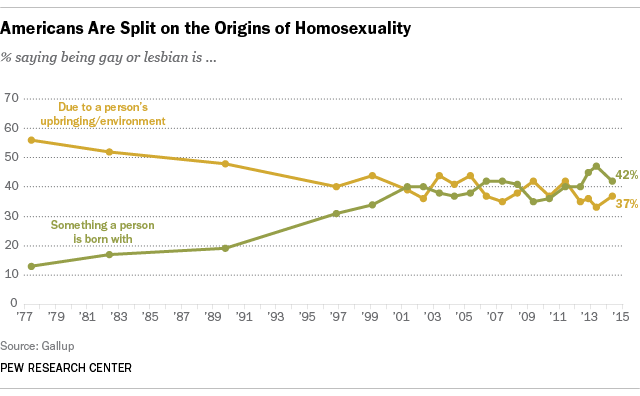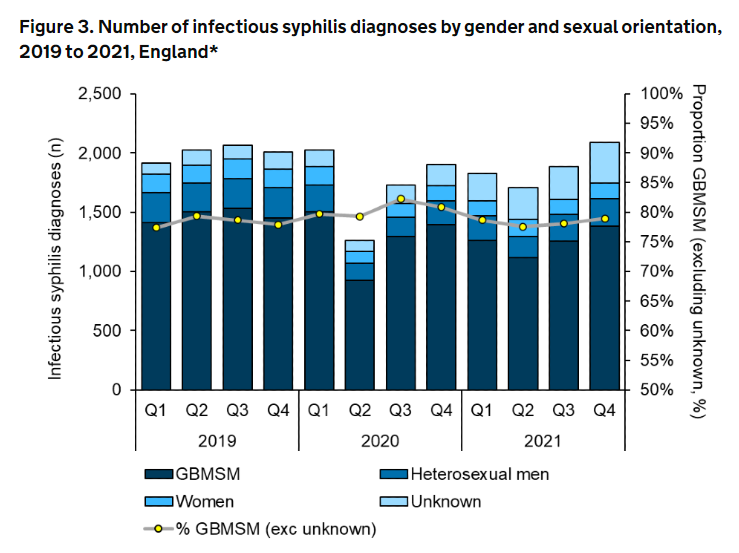A Gay Oddity
Male homosexual trends in the United States and United Kingdom
Note: this post discusses venereal disease, sexualization, and a number of forms of sexual depravity popular in the past and present. I advise that those with a low disgust tolerance read no further - it will be more unpleasant for you to read than it was for me to write. It is unfortunate that these issues have to be thought about at all, but ignoring these sorts of problems allows them to fester. I have only moderate confidence in the data and conclusions presented here, expect to be partially wrong on some points in the near-future, and wouldn’t be surprised to turn out to be largely wrong in the mid-future.
Ooh, there ain't no other way, baby, I was born this way
Baby, I was born this way (born this way)
Ooh, there ain't no other way, baby, I was born this way
I'm on the right track, baby, I was born this way
Don't be a drag, just be a queen
Whether you're broke or evergreen
You're Black, white, beige, chola descent
You're Lebanese, you're Orient'
Whether life's disabilities left you outcast, bullied, or teased
Rejoice and love yourself today
'Cause, baby, you were born this way
No matter gay, straight, or bi', lesbian, transgender life
I'm on the right track, baby, I was born to survive
No matter Black, white or beige, chola, or Orient' made
I'm on the right track, baby, I was born to be brave
So sang Stefani Germanotta (better known as Lady Gaga) in her 2011 song “Born This Way”. The song’s theory is that homosexuals, bisexuals, and transsexuals are born rather than made. That theory was popular in the 2000s and 2010s during the fourth movement (that I’m aware of) for the promotion of sexual deviancy in the United States. The third such movement had largely died off with its supporters during the AIDS epidemic and left only an insignificant ideological legacy.
In the 2000s and 2010s that theory seemed plausible. Polls found as late as 2012 that around 3% of the USian population considered itself to be homosexual, bisexual, or transsexual. USians thus increasingly agreed with the theory, with about equal numbers believing that homosexuals were born and made. However, by 2012 generational differences in sexual identity were noted. Only 1.5% of USians over the age of 65 identified as LGBT compared to 6.4% of USians aged 18-29. There was also an international contrast. Only 2.8% of 16-24 year olds in the United Kingdom identified as LGBT in 2014.
The “born this way” theory is less plausible now. The 2010s and early 2020s saw explosive growth in LGBT identity among USians. CSPI’s Eric Kaufmann wrote an interesting post summarizing the trend. Much of the growth is in identity (ie women who practice heterosexuality identifying as bisexual), but there appears to be a real increase in the number of USians - particularly youths - practicing homosexuality as well. Per his research, about 8% of USian men under 30 practiced homosexuality between 2017 and 2021 - a dramatic rise from the 4.6% who identified as homosexual or bisexual in 2012. Kaufmann’s post also suggests that a little less than half of those who identify currently as LGBT genuinely practice the lifestyle - a dramatic change from the 2000s when there was little reason to identify as LGBT unless one practiced the lifestyle.
Meanwhile, the increase in sexual deviancy was more muted in the United Kingdom. Despite intense cultural interaction between the UK and USA, only 3.3% of UK 16-24 year old males identified as homosexual in 2019, up from 2.1% in 2014. That is, the fraction of homosexual male zoomers seems to be more than twice as high in the United States as it is in the United Kingdom.
While polls and government statistics for identity can be unreliable for categories seen as fluid by the relevant parts of the population, other data suggests that the shift in young male sexuality is real. Syphilis is a serious disease spread mostly by sexual contact which often forms a lesion and which later causes other nasty issues. It is standard practice to test for syphilis when screening for any sexually transmitted infection. Because of that, it is reasonable to assume that the vast majority of those who contract syphilis are tested, and therefore that STI surveillance reports in the United States and United Kingdom are close reflections of reality. Indeed, if anything the universal health care system in the United Kingdom would result in a greater share of the infected tested for syphilis than the United States. Over half of reports of syphilis in the United States involve homosexual men, with the true figure likely about 70% as a significant percentage of male cases of syphilis do not report the sex of their partners.
Syphilis is also a largely disease of homosexual men in the United Kingdom, accounting for around 80% of cases.
The United States’ Center for Disease Control in 2021 reported 171,074 syphilis cases. By contrast, the United Kingdom’s GUMCAD STI Surveillance System reported 7,506 cases in 2021 in England (Scotland, Wales, and Northern Ireland weren’t included). As England’s population is 56 million and the United States’ is 330 million, that means that syphilis rate in the Unites States is 3.87 times higher.
However, data collection is done differently, with the CDC counting all cases of syphilis, while England only counting infectious syphilis. Usually around 80% of English syphilis cases were infectious. In addition, men with African ancestry in both the United States and United Kingdom were dramatically more likely to have contracted syphilis than men of other backgrounds. Blacks are about twice as likely to contract syphilis in the United Kingdom as others, and comprise about 36% of syphilis cases in the United States.
Taking into account the differences in demographics and data collection, the male syphilis rate in the USA is still about 1.85 times that of the UK, which may plausibly suggest in concurrence with polling that male homosexuality is practiced by a significantly greater fraction of young men in the United States than the United Kingdom. Syphilis almost died out in the early 2000s, and has been increasing in fits and bursts since the mid-2000s in both America and Britain, with a particularly dramatic rise in both countries in the mid-2010s. While the rise has both been a predominately male homosexual phenomenon and accompanied with social acceptance (and increasingly promotion) of homosexuality, it cannot be stated with certitude that the spread of syphilis is a function of either increased or broader homosexual activity. After all, only a minority of homosexual men in both countries have contracted the disease, and hygiene practices presumably differ across communities. It is however an additional data point suggesting that there has been a genuine increase in the male practice of homosexuality in the United States.
The broader spread of LGBT identity and practice in the United States has opened up many questions as to the nature of human sexualization. The view advocated by USian elites is that the LGBT identity is 1) innate, 2) that its increased prevalence is due to tolerance allowing individuals to show their true selves, and 3) normal. That view is obviously false - unlike hermaphrodites, humans only produce one type of gamete and thus can only reproduce with a member of the opposite sex. Alleles that increase likelihood of homosexuality are rapidly purged by natural selection, although they could possibly survive at a low frequency if they have other effects that render an organism more fit. No human population can naturally have an eleventh of its men be born homosexual.
Endocrine disruptors have been discussed as a possible cause of abnormal human sexuality. The chemical industry of the United States is ten times the size that of the United Kingdom, so the theory is at least plausible at a glance. If the theory is true, presumably homosexuality would be practiced by a greater fraction of population in low lying areas than at higher elevations. The area around the Mississippi Delta in particular should have an unusually high fraction of homosexuals as the waters of a huge part of the United States flow through it to get to the Gulf of Mexico.
Social contagion theory is more likely, particularly given the extremely rapid changes in sexuality in certain areas which privilege LGBT identities. The theory is well supplemented with a model of sexualization based on imitation and initiation. While today’s society pushes youths towards homosexuality, in the past it could be in different directions. A relevant post from a classicist:
Leda and the Swan is a story and subject in art from Greek mythology in which the god Zeus, in the form of a swan, seduces or rapes Leda on the same night she slept with her husband King Tyndareus of Sparta. She subsequently bears two children from Zeus, Helen (who later becomes Helen of Troy) and Polydeuces (Pollux, one of the Dioscuri) and two children from Tyndareus, Castor (the other Dioscuri) and Clytemnestra. Castor, being the son of a human male, was mortal while Pollux, being a son of Zeus, was immortal. But Pollux asked to share his immortality with his half brother so each spent half their time in Hades while the other communed with gods on Olympus.
Their unusual conception was just one of several Greek myths in which Zeus seduced or abducted favored mortals while in the form of an animal. These other tales included Europa and the bull and Ganymede and the eagle.
Various classical writers recorded that bestiality was common in "other" cultures. Herodotus as well as Pindar, Strabo and Plutarch alleged Egyptian women engaged in sexual relations with goats for religious and magical purposes – the animal aspects of Egyptian deities being particularly alien to the Greco-Roman world. Hittite law mandated the death penalty for intercourse with animals, excluding horses and mules (violators were instead barred from the priesthood and from approaching the king). Likewise, the Abrahamic religions imposed the death penalty on both the person and animal involved in an act of bestiality. I always view the creation of a law as something needed to prohibit behavior deemed unfavorable that is actually occurring.
Plutarch, though Greek himself, and Virgil, too, make similar accusations of bestiality among the Greeks, with Plutarch writing in his "Discourse on the Reason of Beasts" that the Greeks committed "very frequently and in many places great outrages, disorders and scandals against nature, in the matter of this pleasure of love, for there are men who have loved she-goats, sows and mares."
There is some indication that violent sexual encounters, like other mythological scenarios, were acted out as punitive entertainments in the Roman arena. Nero is supposed to have enjoyed a form of bondage with either male or female partners in which he dressed in animal skins to reenact a wild animal attacking a condemned prisoner as frequently occurred in the arena. Cassius Dio also relates how a prostitute pretended to be a leopard for the gratification of a senator. However, such activity was generally viewed by the Romans as undesirable behavior, much like pederasty. But that did not seem to diminish their appreciation of the myth as Leda and the Swan were popular subjects on ceramics and as inspiration for sculpture as well.
The Classical Age Mediterranean, while unusually literate, was hardly an outlier. The practice of bestiality - as well as many other forms of depravity - has been noted across the world, is portrayed in art, and is perhaps remembered in the mythologies of certain societies.
Bestiality is of course extremely rare in the present. There are no public advocates for it (at least none that I’m aware of), it has no protections under civil rights, and those who idealize or engage in it are a tiny minority. Whatever social processes drove it either died off or were successfully suppressed (Germany arrested more men for bestiality than for sodomy until 1909). Homosexuality was similar within living memory. A mere 0.3% of UK residents over the age of 65 identified as homosexual in 2014, and only 0.6% identified as homosexual five years later. Only 1.9% of USians over the age of 65 identified as LGBT in 2012. While such low figures used to be seen as underestimates due to presumed taboos that still held sway with respondents, the only slight increase of LGBT identity among the elderly even after the removal of such taboos in the last decade suggests that the results were in fact quite close to the truth. After all, a majority of 55+ year olds in the USA supported gay marriage by the mid-2010s.
It is curious that much as youths in the UK are considerably less likely to be homosexual than their counterparts in the USA, so are the elderly. This appears to track back at least as far back as the 1990s, when AIDS deaths in the United Kingdom were about a twentieth of the AIDS deaths in the United States even though it had a fifth of the population.
HIV/AIDS cases in the United Kingdom (above) and the United States (below) from 1980s to 2010s
It seems doubtful that the third movement for the promotion of sexual deviancy had much of an effect on USian sexuality. Its activists were quite marginalized and widely despised, only influential in a handful of places such as San Francisco. They had no internet that they could use to reach the masses, and the media’s pro-LGBT campaigns were only just beginning. The most famous institution with a significant proportion of homosexuals was the Catholic Church, but even its massive abuse scandal affected fewer than 20,000 boys in a country of 203 million - hardly enough to explain the dramatically higher rates of homosexuality in the United States.
Why is the United States so much gayer than the United Kingdom? More research is needed.








Have you ever looked at rates of childhood sexual abuse among LGBTQ community people? I remember looking at several studies with quite alarming rates. It may be another piece to this puzzle.
Contrary to the idea of “born that way” which implies a biological determinant of sexuality, I’ve always considered it highly likely that homosexuality is a condition which could be caused by any one of a number of things. Same sex attraction is the symptom, but the cause of the symptom can be different from individual to individual. One might have a biological predisposition, another may have been sexually abused as a child. A boys relationship with a parent, choice, the bullying of a sensitive natured child which leads to a self-fulfilling prophecy. It seems evident that human sexuality is somewhat plastic (think of prison populations, ancient warrior cultures, the British Navy, etc). It is so because it has evolved to fill a social function and not just a reproductive one. Thus quite a number of things could cause one to change orientation.